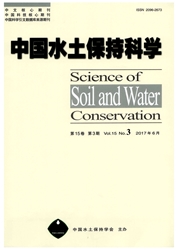

 中文摘要:
中文摘要:
侵蚀泥沙颗粒大小的分布在一定程度上影响着侵蚀泥沙的搬运和沉积,了解侵蚀泥沙的分选作用将有助于解释泥沙的侵蚀和沉积过程。该文以覆沙坡面为研究对象,采用室内模拟降雨的方法,选取坡度12°、雨强1.5 mm/min的黄土坡面上分别覆盖0.5、1.0、1.5 cm的沙层进行试验。结果表明:坡面覆沙后,坡面粗颗粒物质大部分在产流开始0-10 min内便被冲刷带走;侵蚀泥沙颗粒主要以粉粒为主;坡面覆沙后,在细沟间侵蚀阶段,径流优先搬运大于0.054 mm的颗粒,在细沟侵蚀阶段和细沟侵蚀及细沟间侵蚀的组合阶段,径流搬运的泥沙颗粒以小于0.054 mm的颗粒为主;同时,在产流前期(0-10 min)侵蚀泥沙颗粒主要以大于0.054 mm的颗粒为主;而在产流后期(10 min以后)侵蚀泥沙则主要以小于0.054 mm的颗粒为主。坡面覆沙后,黏粒以团聚体的形式存在,粉粒以单粒的形式存在,而沙粒以细颗粒聚集体的形式存在。该文为进一步研究泥沙沉积后风蚀对水蚀的影响提供数据支撑。
 英文摘要:
英文摘要:
Sediment size distribution greatly affects sediment transport and deposition. A better understanding of sediment sorting will improve the understanding of erosion and sedimentation processes, which in turn will improve erosion modeling. In this paper, using artificially simulated rainfall experiment, the sieved sand slope erosion and sediment grain size distribution and the change process were analyzed under the condition of 1.5 mm/min rainfall intensity, and the sieved sand slope erosion and sediment particle characteristics were explored, which aimed to further clarify the sieved sand slope erosion and sediment yield process. This paper studied the characteristics of sediment particles under different sand thickness, and there were 3 treatments, i.e. ST1(sand thickness of 0.5 cm), ST2(sand thickness of 1.0 cm), and ST3(sand thickness of 1.5 cm). Malvern 2 000 laser particle size analyzer was used to measure the sediment particle composition, which was expressed by the mean weighted diameter(MWD). The results showed that most of coarse particulate matter was washed away within 0-10 min after the runoff production began; the sediment particle content of less than 0.054 mm was ST2〈ST3〈ST1 in 0-5 min after runoff, and that of greater than 0.054 mm was ST3〈ST1〈ST2; however, the sediment content less than 0.054 mm decreased with the increase of the thickness of sand-covered, the content of sediment particles larger than 0.054 mm increased with the increase of the thickness of sand-covered after the 6th min of runoff; the erosion and sediment particles were mainly composed of silt; compared with bare slope, the E/U(effective particles/ultimate particles) value of clay in the erosion and sediment particles in 0-5 min was reduced by 36%, 64% and 58% respectively, and that of silt was reduced by 48%, 69%, 63% respectively when the thickness of sand was 0.5, 1.0, 1.5 cm respectively. For the sand covered slope, in the inter-rill erosion stage, runoff gave priority to transport the particles mor
 同期刊论文项目
同期刊论文项目
 同项目期刊论文
同项目期刊论文
 期刊信息
期刊信息
